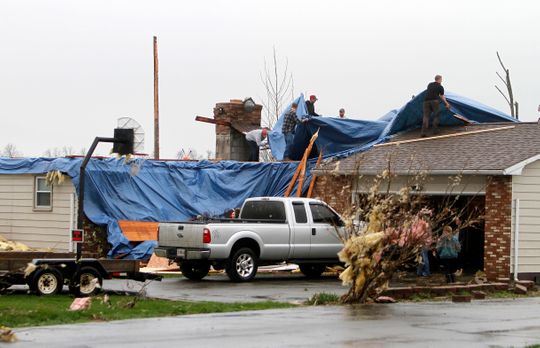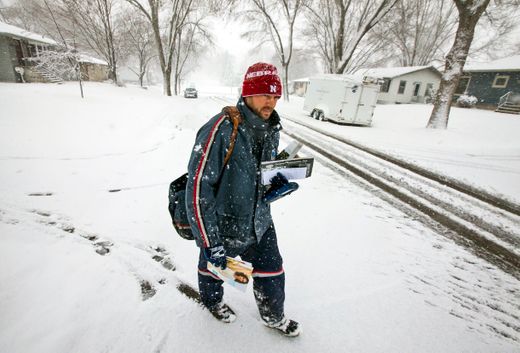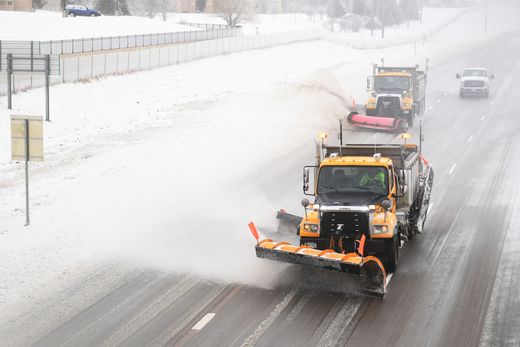Tornadoes in the South, floods and snow in the Midwest, crazy heat in Alaska. What's going on with the extreme weather this year?
Most of it is par for the course, experts say, because we live in the nation with the world's wildest weather extremes: No other country on Earth has the USA's ferocious weather stew of hurricanes, tornadoes, droughts, floods, wildfires, blizzards, heat waves and cold snaps.
"You'd be hard-pressed to find another patch of land on Earth the size of the USA that boasts such a variety of such intensely extreme weather inside its borders," said meteorologist and author Robert Henson of Boulder, Colorado.
In April, severe weather outbreaks such as the one that hit the South on Sunday are the norm rather than the exception. So far this April, 48 tornadoes have hit the U.S., according to preliminary data from the Storm Prediction Center. That's still well below normal for mid-April. (On average, 115 tornadoes have hit by this time of April, said Patrick Marsh, the storm center's warning coordination meteorologist.)
The death and destruction from the tornadoes that have hit this year might appear shocking in part because of the freakishly quiet year of 2018: Both the number of Americans killed by tornadoes (10) and the number of violent tornadoes in the U.S. (zero) set record lows. (Violent tornadoes are those with estimated wind speeds of 166 mph or higher – EF4 or EF5 twisters on the Enhanced Fujita Scale of Tornado Intensity.)
More statistics: While the eight deaths from severe storms was certainly a tragedy on Sunday, the number pales in comparison to the horrific tornado outbreak of Palm Sunday 1965, when 271 people were killed by 47 tornadoes.

People work to cover the holes in a roof after severe weather damaged homes on Plymouth Springmill Road just south of the intersection of Ohio Route 96 in Shelby, Ohio, on April 14, 2019. (Photo: Tom E. Puskar, AP)
Tornadoes, such as the ones that slammed Texas on Wednesday, are nearly a uniquely American phenomenon. Each year, "the U.S. experiences about 80% to 90% of all the tornadoes that occur across the world," says Randy Cerveny, a professor of geography at Arizona State University.
While climate change does have a documented effect on many extreme weather events, it has no clear connection to severe thunderstorms nor the tornadoes they produce. In fact, a 2016 report from the National Academy of Sciences found that of all weather phenomena, severe storms have the least connection to human-caused climate change.
That's not the case for other types of extreme weather, however: That report found there were clear links between climate change and heat waves, droughts, heavy rain and snowstorms.
The floods that swamped the central U.S. after the first "bomb cyclone" snow and rain storm in March had a climate change connection, scientists said last month. The root causes of the floods – like wetter weather and rapid spring warm-ups – also have become more likely because of climate change, according to Yale University.
The flooding was consistent with projections in a government report last November, the National Climate Assessment Volume II, which said climate change would increase the frequency of powerful storms.
Climate change, or global warming, is caused by burning fossil fuels such as coal, oil and gas, which release greenhouse gases like carbon dioxide and methane into the Earth's atmosphere and oceans. That has raised the global temperature and also worsened climate and weather disasters around the world, the U.N. has said.
Though its made few headlines, some of the USA's weirdest weather this year has been the extreme heat in Alaska this spring. Alaska had its warmest March since records began 95 years ago, according to the National Oceanic and Atmospheric Administration.



The Alaska statewide March temperature was 26.7 degrees, a mind-boggling 15.9 degrees above the long-term average. (Most monthly temperature records are broken by a few degrees, or even tenths of degrees.) That exceeded the previous warmest March in 1965 by more than 3 degrees, NOAA said.
In fact, all long-term climate stations north of the Alaska Range and Bristol Bay had their warmest March on record. And amazingly, Kotzebue's average March temperature was warm enough to be among its 10 warmest Aprils on record, NOAA said.
Heat waves remain one of the clearest signals of Earth's warming climate, as reports from the U.N. and the National Climate Assessment both have shown.







